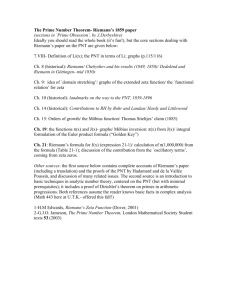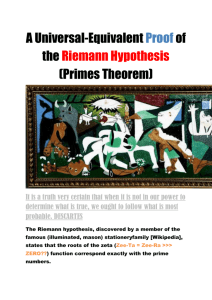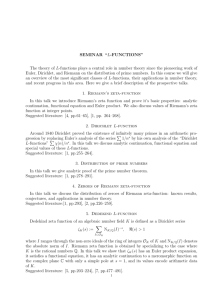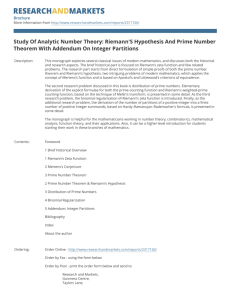Numerical evaluation of the Riemann Zeta-function
advertisement
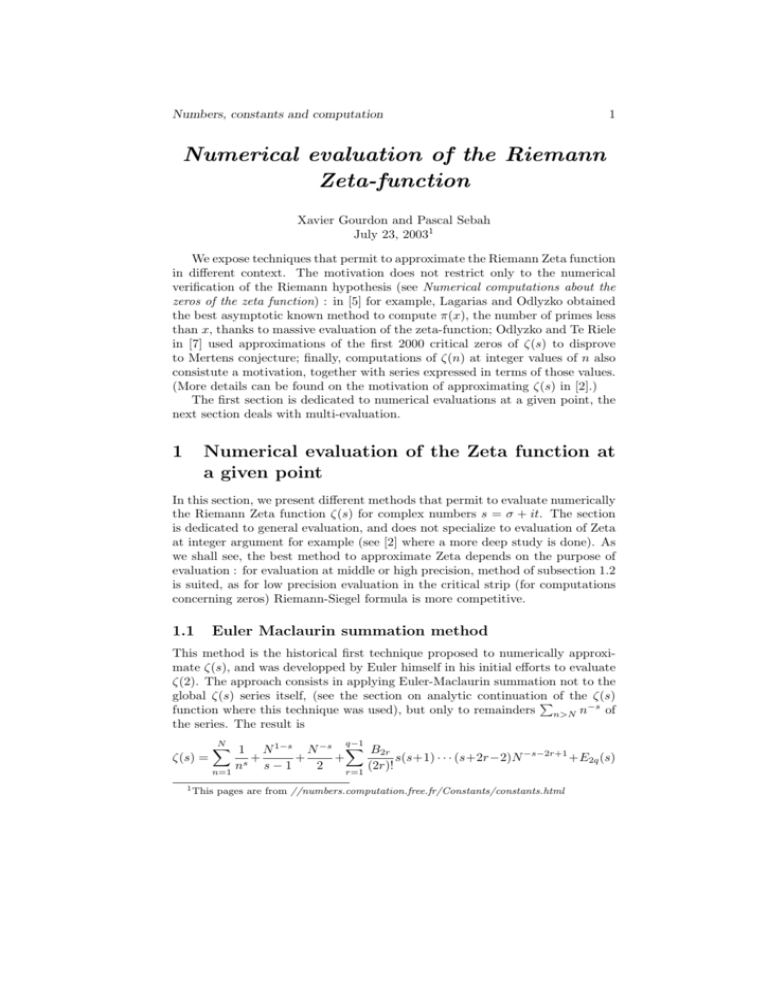
Numbers, constants and computation
1
Numerical evaluation of the Riemann
Zeta-function
Xavier Gourdon and Pascal Sebah
July 23, 20031
We expose techniques that permit to approximate the Riemann Zeta function
in different context. The motivation does not restrict only to the numerical
verification of the Riemann hypothesis (see Numerical computations about the
zeros of the zeta function) : in [5] for example, Lagarias and Odlyzko obtained
the best asymptotic known method to compute π(x), the number of primes less
than x, thanks to massive evaluation of the zeta-function; Odlyzko and Te Riele
in [7] used approximations of the first 2000 critical zeros of ζ(s) to disprove
to Mertens conjecture; finally, computations of ζ(n) at integer values of n also
consistute a motivation, together with series expressed in terms of those values.
(More details can be found on the motivation of approximating ζ(s) in [2].)
The first section is dedicated to numerical evaluations at a given point, the
next section deals with multi-evaluation.
1
Numerical evaluation of the Zeta function at
a given point
In this section, we present different methods that permit to evaluate numerically
the Riemann Zeta function ζ(s) for complex numbers s = σ + it. The section
is dedicated to general evaluation, and does not specialize to evaluation of Zeta
at integer argument for example (see [2] where a more deep study is done). As
we shall see, the best method to approximate Zeta depends on the purpose of
evaluation : for evaluation at middle or high precision, method of subsection 1.2
is suited, as for low precision evaluation in the critical strip (for computations
concerning zeros) Riemann-Siegel formula is more competitive.
1.1
Euler Maclaurin summation method
This method is the historical first technique proposed to numerically approximate ζ(s), and was developped by Euler himself in his initial efforts to evaluate
ζ(2). The approach consists in applying Euler-Maclaurin summation not to the
global ζ(s) series itself, (see the section on analytic continuation
Pof the ζ(s)
function where this technique was used), but only to remainders n>N n−s of
the series. The result is
q−1
N
X
1 N 1−s N −s X B2r
+
+
s(s+1) · · · (s+2r−2)N −s−2r+1 +E2q (s)
+
ζ(s) =
s
n
s
−
1
2
(2r)!
r=1
n=1
1 This
pages are from //numbers.computation.free.fr/Constants/constants.html
Numbers, constants and computation
2
(see [4] for details) for any complex number s = σ+it (with σ = <(s) > −2q+1).
The terms B2r are the Bernoulli numbers. Backlung gave an estimate of the
error term E2q (s) in the form
s(s + 1) · · · (s + 2q − 1)B2q N −s−2q+1 .
|E2q (s)| < (2q)!(σ + 2q − 1)
However, this method is not very easy to use in the practice since it requires
evaluations of numerous Bernoulli numbers, and the error term is difficult to
control in this non-convergent expansion (see [2] where this difficulty is presented). Moreover, even with choosing carefully the parameters N and q, the
rate of convergence is not better than the one obtained with other simpler techniques based on acceleration of alternating series presented below.
1.2
Convergence of alternating series method
A better method, more efficient and easier to implement, is based on the alternating series convergence (see [1]). It applies to complex numbers s = σ + it
with σ = <(s) > 0. The starting point is the Zeta alternating series
ζa (s) =
∞
X
(−1)n−1
= (1 − 21−s )ζ(s).
s
n
n=1
(1)
We apply the general technique of convergence of alternating series of [3] described in Acceleration of the convergence of series. The technique applies because the general term of the series 1/(n + 1)s is of the form
Z 1
1
log(1/x)s−1
f (x)xn dx, with f (x) =
=
s
(n + 1)
Γ(s)
0
Pn
k
Let Pn (x) =
k=0 pk (−x) be a polynomial such that Pn (−1) 6= 0, and let
define Sn as
Sn =
n−1
X
(−1)k
1
ck
,
Pn (−1)
(k + 1)s
ck =
k=0
n
X
pj .
j=k+1
Then we have the identity
ζa (s) − Sn = ξn ,
ξn =
1
Pn (−1)Γ(s)
Z
0
1
Pn (x)(log(1/x))s−1
dx.
1+x
(2)
As always, polynomials (Pn ) are choosen such that supx∈[0,1] |Pn (x)/Pn (−1)|
is small, making the value of ξn small. In [1], this identity is used with two
families of polynomials (Pn ) : the Chebyshev polynomials shifted to [0, 1], and
the polynomials xn (1 − x)n , giving the two following results :
Numbers, constants and computation
3
Proposition 1 Let
dk = n
n
X
(n + j − 1)!4j
j=k
then
(n − j)!(2j)!
n
X (−1)k−1 dk
1
+ γn (s)
1−s
d0 (1 − 2 )
ks
ζ(s) =
k=1
where for s = σ + it with σ ≥
|γn (s)| ≤
(3 +
2
√
1
2
1
(1 + 2|t|)e|t|π/2
1
3
√
≤
8)n |Γ(s)| |1 − 21−s |
(3 + 8)n |1 − 21−s |
This approach, to compute ζ(σ + it) with d decimal digits of acurracy, requires a number of term n roughly equal to 1.3d + 0.9|t|.
The next approach is based on the choice of the polynomial xn (1−x)n . Even
if a little less efficient, the technique is simpler. This time, the integral in (2)
is convergent whenever σ = <(s) > −(n − 1), thus the technique can be also
applied in this range.
Proposition 2 Let
ek =
n X
n
j=k
j
then
n
X
(−1)k−1
1
ζ(s) =
(1 − 21−s )
k=1
ks
2n
1 X (−1)k−1 ek−n
+ n
2
ks
!
+ γn (s)
k=n+1
where for s = σ + it with σ > 0
|γn (s)| ≤
1 (1 + |t/σ|)e|t|π/2
.
8n
|1 − 21−s |
If −(n − 1) < σ < 0 then
|γn (s)| ≤
4|σ|
1
.
8n |1 − 21−s | |Γ(s)|
Computational aspects
This technique is easy and efficient to compute ζ(s) with middle or high accuracy, for values of s with small imaginary part (in [1], computational experiments on the computation of ζ(5) have been made proving the efficiency of
this approach compared to Zeta evaluation in classic computer algebra systems
like Maple, Mathematica or Pari). In the practice, one should compute the
terms sequentially, doing a fixed number of additions and multiplications per
Numbers, constants and computation
4
term. One should also notice that for integer values of s, the binary-splitting
technique can be used making these formula suitable for huge computations in
quasi-linear time.
To compute values of ζ(1/2 + it) for very large values of t, (even with a low
precision of 10 digits for example) a number of needed terms proportional to |t|
is required. As we will see below, Riemann-Siegel formula is more suited in this
context.
1.3
The Riemann-Siegel formula
The Riemann-Siegel formula permits to approximate ζ(σ + it) in the critical
strip 0 ≤ σ ≤ 1 for large values of t with a number of terms proportional to
p
|t| (which is much better than previous methods that requires a number of
terms proportional to |t|). It states in the general form as follows.
Theorem 1 (Riemann-Siegel formula) Let x and y be positive real numbers
such that 2πxy = |t|. Then for s = σ + it with 0 ≤ σ ≤ 1, we have
ζ(s) =
X 1
X 1
+ χ(s)
+ O(x−σ ) + O(|t|1/2−σ y σ−1 ),
s
n
n1−s
n≤x
(3)
n≤y
where the O holds uniformly for x > h and y > h for any h > 0.
We remind that χ(s), often used to express functional equation of Zeta, is defined
by
πs χ(s) = 2s π s−1 sin
Γ(1 − s).
2
Formula (3) looks like the functional equation, for that reason it is also called
the approximate functional equation. A proof can bepfound in [10] for example.
It is natural to use this formula when x = y = |t|/(2π), which writes in
the form
$ %
m
m
1/2
X
X
1
|t|
1
+
χ(s)
+
E
(s),
m
=
ζ(s) =
(4)
m
ns
n1−s
2π
n=1
n=1
where the error term Em (s) satisfies
Em (s) = O(|t|−σ/2 ).
An asymptotic expansion of the error term Em (s) can be given explicitly (see [10]
or [8]), but it is complicated in its general form and we just give its first terms
in the particular (but important) case σ = 1/2 below.
Riemann-Siegel formula on the critical line
It is interesting to specialize the Riemann-Siegel formula on the critical line σ =
1/2. We first define the Riemann-Siegel Z-function which permits a convenient
study of ζ(s) in this zone.
Numbers, constants and computation
5
Figure 1: The Riemann Siegel function Z(t) for values of t near 0. In dashed,
the value of |ζ( 12 + it)|.
The Riemann-Siegel Z-function
The χ(s) function satisfies χ(s)χ(1 − s) = 1, thus for s =
1
2
+ it we have
χ( 12 + it)χ( 12 − it) = 1
so that |χ( 12 + it)| = 1. Therefore, we can define implicitly the θ(t) real function
as
eiθ(t) = χ( 12 + it)−1/2 ,
(5)
with θ(0) = 0. Equivalently, it easily shown that θ(t) also satisfy
θ(t) = arg π −it/2 Γ( 41 + i 2t )
(6)
where the argument is defined by continuous variation of t starting with the
value 0 at t = 0.
The Riemann-Siegel Z-function (also called Hardy Z-function in [2]) is defined for real values of t by
Z(t) = exp(iθ(t))ζ( 21 + it).
(7)
The functional equation of the Zeta function entails ζ( 21 −it) = χ( 12 −it)ζ( 12 +it)
and we easily deduce that Z(t) = Z(t). In other words, the Z-function is
purely real and the equality |Z(t)| = |ζ( 21 + it)| holds. This wonderful property,
illustrated in figure 1, makes this function convenient for the study of ζ(s) on
the critical line.
Riemann-Siegel formula applied on the Z-function
Multiplying (4) by exp(iθ(t)) for s =
Z(t)
= eiθ(t)
m
X
n=1
1
2
+ it, we obtain
n−1/2−it + e−iθ(t)
m
X
n=1
n−1/2+it + O(t−1/4 )
Numbers, constants and computation
=
2
6
m
X
cos(θ(t) − t log n)
√
+ O(t−1/4 ).
n
n=1
(8)
This concise formula is very suitable for computation of Z(t) for large values of
t, as needed in computations relative to zeros of the zeta function. For precise
computations, asymptotic formula of the error term is also available, and (using
formulation of [2]) one has for positive t
Z(t)
=
2
m
X
cos(θ(t) − t log n)
√
+
n
n=1
(−1)m+1 τ −1/2
M
X
(−1)j τ −j Φj (z) + RM (t),
(9)
j=0
with RM (t) = O(t−(2M +3)/4 ), where we used the notations
r
t
, m = bτ c, z = 2(t − m) − 1.
τ=
2π
The first functions Φj (z) are defined by
Φ0 (z)
=
Φ1 (z)
=
Φ2 (z)
=
cos( 12 πz 2 + 38 π)
cos(πz)
1
(3)
Φ (z)
12π 2 0
1
1
(2)
(6)
Φ0 (z) +
Φ (z)
2
16π
288π 4 0
The general expression of Φj (z) for j > 2 is quite complicated and we refer to [6]
or [10] for it. As exposed in [2], explicit bounds have been rigorously obtained
on the error term RM (t), and for t ≥ 200, one has
|R0 (t)| ≤ 0.127 t−3/4 ,
|R1 (t)| ≤ 0.053 t−5/4 ,
|R2 (t)| ≤ 0.011 t−7/4 .
To be able to completly approximate Z(t) thanks to formula (9), it remains to
give an approximation of the θ(t) function which is obtained from expression (6)
using Stirling series, giving
θ(t) =
t
t
t
π
1
7
log
− − +
+
+ ···
2
2π 2
8
48t 5760t3
(10)
Practical approximation considerations
For practical purposes in computations relative to zeros of ζ(s) it is not necessary
to compute precisely the zeros but just to locate them, and using M = 1 or
M = 2 in formula (9) is usually sufficient. For t around 1010 for example,
the choice M = 1 permits to obtain an absolute precision of Z(t) smaller than
2 × 10−14 , and with M = 2 the precision is smaller than 5 × 10−20 . As for the
Numbers, constants and computation
7
√
number of terms involved in the sum of (9), it is proportional to t which is
much better than previous approaches without Riemann-Siegel formula which
required a number of terms of order t. For t ' 1010 for example, Riemann-Siegel
formula only requires m ' 40, 000 terms, whereas approach of proposition 1
requires at least ' 9 × 109 terms.
2
Multi-evaluation of the Zeta function
Quite recently, Odlyzko and Schönhage in [8] gave an algorithm that is able to
compute efficiently values of ζ(σ + it) at multiples values of of t. More precisely
and roughly speaking, the algorithm is able to compute T 1/2 approximations of
ζ(σ + it) in a range of the form T ≤ t ≤ T + T 1/2 in time O(T 1/2+ ) and using
O(T 1/2+ ) bits of storage, whereas single evaluations at the same values with
techniques presented above would require a time proportional to T .
We do not present the algorithm in its general form and we concentrate
on evaluations on the critical line σ = 1/2 (and in fact on evaluations of the
Riemann-Siegel function Z(t)) that are used for numerically checking the Riemann hypothesis. In this context, the general and original algorithm of [8] has
been refined for practical implementation by Odlyzko (see [9]). We sketch here
the main ideas of this approach.
2.1
The Odlyzko-Schönhage algorithm for multievaluation
of Z(t) : generalities
The algorithm spends most of the time in the computation of
$ %
k1
1/2
X
t
1
√ exp(it log k),
k1 =
.
F (t) =
2π
n
n=1
(11)
From Riemann-Siegel formula (9), the value of Z(t) is easily obtained from the
value of F (t) as the real part of 2 exp(−iθ(t))F (t) and adding remainder terms.
We thus concentrate on multi-evaluations of F (t). The algorithm is divided
in two steps : first, values of F (t) are computed on a regular grid of abscissa
for t (see 2.2). From these values, an interpolation formula permits to obtain
efficiently any value of F (t) at a certain accurracy (see 2.3).
2.2
Multievaluation on a regular grid of absissa
We describe here how Odlyzko-Schönhage algorithm permits to evaluate efficiently approximations of the values F (t) at evenly spaced values t = T , T + δ,
. . ., T + (R − 1)δ. We will later precise what values of δ and R we should choose.
Instead of computing directly the values F (T ), F (T +δ), . . ., F (T +(R−1)δ),
the key idea of [8] is to compute their discrete Fourier transform, defined by
uk =
R−1
X
j=0
F (T + jδ)ω −jk ,
ω = exp(2iπ/R),
Numbers, constants and computation
8
for 0 ≤ k < R. The property of the inverse Fourier transform gives
F (T + jδ) =
R−1
1 X
uk ω jk .
R
k=0
In the algorithm, the value of R is choosen to be a power of two, so the values
F (T + jδ) are efficiently obtained from the (uk ) with an FFT transform. As
described by Odlyzko in [9], this FFT takes a negligeable portion of the time.
So the problem is now reduced to computing efficiently the (uk ). Using the
definition (11) of F (t) and exchanging the order of summations, we obtain that
uk = ω k f (ω k ), where f (z) is defined by
f (z) =
k1
X
k=1
ak
,
z − bk
bk = eiδ log k ,
ak =
eiT log k
(1 − eiRδ log k ),
k 1/2
and we are now lead to compute efficiently the complex values f (ω k ) for 0 ≤
k < R. The idea is to use Taylor series expansions for different subset of the
functions in the sum. Given a complex number z0 on the unit circle and given
L, 0 < L < 1, consider for example the subset I of indices in {1, 2, . . . , k1 } such
that |bk − z0 | > L for all k ∈ I. We have the Taylor series expansion
X ak
X
X
fI (z) ≡
=
An (z0 − z)n ,
An =
(z0 − bk )−n−1
z − bk
k∈I
n≥0
k∈I
valid for all z on the unit circle with |z − z0 | < L. When restricting to z with
|z − z0 | < L/2 for example, the convergence of the Taylor series expansion is
better than (1/2)n and a fixed number of terms (say V ) in this expansion is
sufficient to obtain a given absolute precision. Approximations of values fI (ω j )
for indices j such that |ω j − z0 | < L/2 (let us call J this set of indices) are then
obtained from this Taylor series expansion. When the number of elements in I
is much bigger than the number of terms V used in the series expansion, this
gives a much more efficient method to compute the values (f (ω j ))j∈J . This idea
is used in [8]Pas a basic ingredient of a sophisticated method that writes f (z)
in the form
fI` , the (I` ) being a partition of {1, 2, . . . , k1 } choosen such that
Taylor series convergence of fI` is well controlled.
2.3
Band limited function interpolation
In the previous paragraph, we have seen how to compute efficiently an approximation of the set of values F (T ), F (T +δ), . . ., F (T +(R−1)δ). Our goal here is
to show how to compute efficiently F (t) for any t with T ≤ t ≤ T + (R − 1)δ using an interpolation of these precomputed values. The approach presented in [8]
was to compute several of the derivative F (h) (T + jδ) and to compute desired
value of F (t) by expanding in a Taylor series around the nearest grid point. This
approach has been significantly improved in [9] where a band-limited function
interpolation is used that permits to rely only on evaluations F (T + jδ) and to
use a less dense grid.
Numbers, constants and computation
9
The band-limited function interpolation is classical in signal theory for example. Under mild conditions, it states that a function with a spectrum in
[−τ, τ ]
Z
τ
g(x)eixt dx
G(t) =
−τ
is determined by its samples at nπ/τ with n an integer, and more precisely we
have the “cardinal series”
G(t) =
+∞
X
G
n=−∞
nπ sin(tτ − nπ)
.
τ
tτ − nπ
However, this series has a too slow convergence, and the idea of Odlyzko was to
use a denser sampling to obtain a faster convergence. He applied his approach
to the function
log k1
G(t) = F (t)e−iαt ,
α=
2
which spectrum is in [−τ, τ ] with τ =
F (t) =
log k1
2 ,
and obtained the representation
+∞
nπ
sin λ(nπ/β − t)
λ X
F
e−iα(nπ/β−t)
h(nπ/β − t)
β n=−∞
β
λ(nπ/β − t)
(12)
for any β > τ , with λ = (β + τ )/2, and where h(u) is a kernel function choosen
as
c
sinh(c2 − 2 u2 )1/2
h(u) =
,
= (β − τ )/2
sinh(c) (c2 − 2 u2 )1/2
where c is any fixed real positive constant. In his computations, Odlyzko chose
β ' 1.44α (thus δ = π/β) and c = 30, and observed that this choice permits
to approximate values of F (t) with a precision of more than (roughly) 10 digits
using roughly 200 terms of the sum in (12).
2.4
More on Odlyzko-Schönhage algorithm
The complete algorithm is presented in [9], where in the context of zeros of the
zeta-function on the critical line σ = 1/2, a lot of optimizations and practical
considerations are presented. Among the important improvements, Odlyzko
applies the multi-evaluation algorithm not directly to the function F (t) we have
presented, but to the function
F (k0 , k1 ; t) =
k1
X
1
√ exp(it log k)
n
k=k0
where k0 is a small integer that permits, in the band-limited function interpolation of Odlyzko, to decrease the size τ of the support spectrum of G(t) (and
thus to optimize the interpolation), with k0 small enough so that the rest of the
Numbers, constants and computation
10
P
contribution 1≤k<k0 takes a small amount of time to compute. In [9] computations are done near the zero number 1020 , for which a special care is taken to
the numerical imprecisions in all steps of the algorithm.
As for the added-value of this method compared to the classic RiemannSiegel single evaluation method, Odlyzko estimates in [9] that for computing
zeros of ζ(s) on the critical line near zero number 1020 , his implementation of
this algorithm is roughly 2 × 105 faster, which proves the practical efficiency of
the method.
References
[1] D. Borwein, P. Borwein, A. Jakinovski, “An efficient algorithm for the Riemann Zeta function”, (1995) available from the CECM preprint server,
URL= http://www.cecm.sfu.ca/preprints/1995pp.html, CECM-95-043.
[2] J. Borwein, D. Bradley, R. Crandall, “Computational strategies for the Riemann Zeta Function”, (1999) available from the CECM preprint server,
URL= http://www.cecm.sfu.ca/preprints/1999pp.html, CECM-98-118.
[3] H. Cohen, F. Rodriguez Villegas, D. Zagier, Convergence acceleration of
alternating series, Bonn, (1991)
[4] H. M. Edwards, Riemann’s Zeta Function, Academic Press, 1974.
[5] J. Lagarias and A. Odlyzko, “Computing π(x) : an analytic method,” J.
Algorithms 8, (1987), 173-191.
[6] Eric W. Weisstein, “Riemann-Siegel functions”, available from the
MathWorld site at URL= http://mathworld.wolfram.com/RiemannSiegelFunctions.html
[7] A. Odlyzko, H. J. J. te Riele, “Disproof of the Mertens conjecture,” J. Reine
angew. Math. 357 (1985), 138-160.
[8] A. Odlyzko, A. Schönhage, “Fast algorithms for multiple evaluations of the
Riemann zeta-function,” Trans. Amer. Math. Soc. 309 (1988), 797-809.
[9] A. Odlyzko, “The 1020 -th zero of the Riemann zeta function and 175 million of its neighbors”, unpublished manuscript, 1992. Available at URL=
http://www.research.att.com/ amo/unpublished/index.html.
[10] E. C. Titchmarsh, The theory of the Riemann Zeta-function, Oxford Science publications, second edition, revised by D. R. Heath-Brown (1986).
[11] J. van de Lune, H. J. J. te Riele and D. T. Winter, On the zeros of the
Riemann zeta function in the critical strip, IV. Math. Comp. 46 (1986),
667-681.




